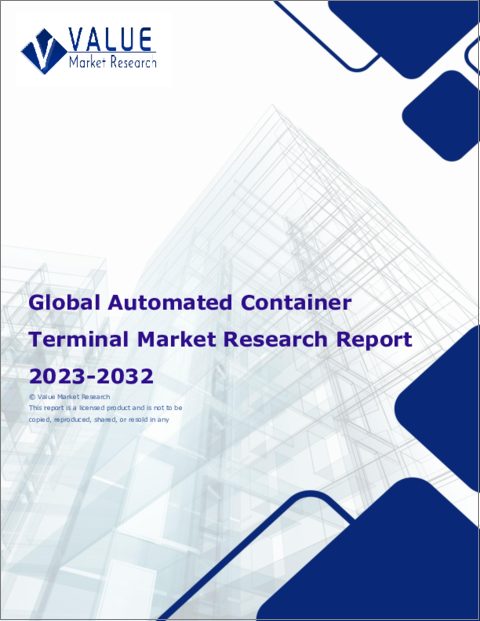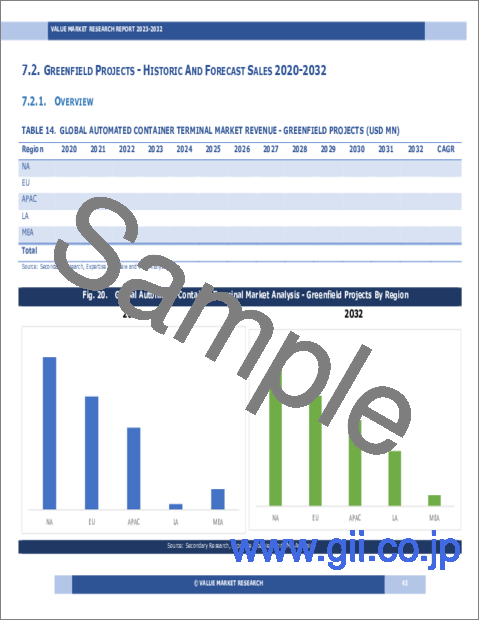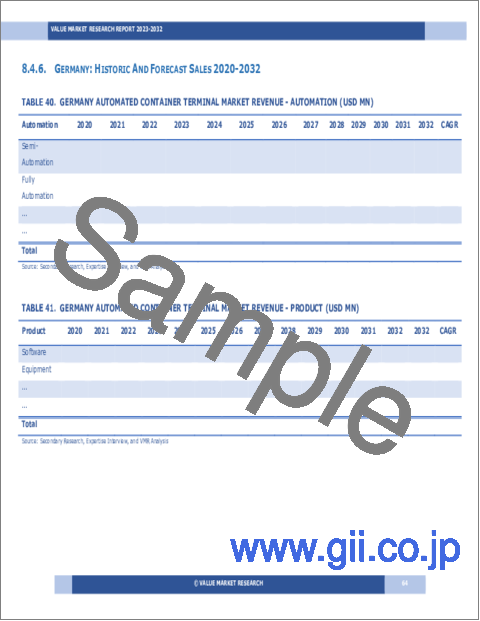|
|
市場調査レポート
商品コード
1306990
自動コンテナターミナルの世界市場調査レポート:産業分析、規模、シェア、成長、動向、2023年から2030年予測Global Automated Container Terminal Market Research Report - Industry Analysis, Size, Share, Growth, Trends and Forecast 2023 to 2030 |
||||||
|
● お客様のご希望に応じて、既存データの加工や未掲載情報(例:国別セグメント)の追加などの対応が可能です。 詳細はお問い合わせください。 |
|||||||
| 自動コンテナターミナルの世界市場調査レポート:産業分析、規模、シェア、成長、動向、2023年から2030年予測 |
|
出版日: 2023年05月01日
発行: Value Market Research
ページ情報: 英文 200 Pages
納期: 即日から翌営業日
|
- 全表示
- 概要
- 図表
- 目次
自動コンテナターミナル市場の世界需要は、調査期間2023~2030年のCAGR4.67%で、2022年の124億2,000万米ドルから2030年にはおよそ171億米ドルの市場規模に達すると推定されます。
自動コンテナターミナルは、コンテナ処理作業を行うために高度な自動化技術を使用する港湾ターミナルです。通常、クレーン、輸送車両、ソフトウェアなど、さまざまな自動化システムが含まれ、これらのシステムが連携してコンテナの積み下ろし、船、トラック、列車間のコンテナの移動を行う。自動コンテナターミナルでは、コンテナ荷役作業の大部分は手作業ではなく、自動化された機器によって行われます。これには、自動スタッキングクレーン、自動誘導車、コンテナヤード管理システムなどが含まれます。機器は高度なソフトウェアとセンサーによって制御され、コンテナが安全かつ効率的に処理されることを保証します。
市場力学:
グローバル化、電子商取引、都市化などの要因によるコンテナ輸送需要の増加は、より効率的で費用対効果の高いコンテナ処理ソリューションの必要性を高めています。 自動コンテナターミナルは、従来のコンテナ・ターミナルと比較して優れた効率性を示し、短時間で大量のコンテナを処理することを可能にします。この能力は、容量の制限に遭遇している港湾や、処理能力の向上を求めている港湾にとって特に重要です。これらのターミナルは、エネルギー消費と排出を削減することで、コンテナ荷役作業による環境への影響を軽減することができます。これは、持続可能性の目標を達成し、二酸化炭素排出量を削減しようとしている港湾にとって、ますます重要になってきています。自律走行車、高度なセンサー、機械学習アルゴリズムの開発など、自動化技術の進歩により、コンテナ荷役作業のより多くの側面を自動化することが可能になっています。このことが、より高度で効率的な自動コンテナターミナル・ソリューションの開発を後押ししています。これらのターミナルは、手作業の必要性を最小限に抑えることで、人件費を削減し、安全性を高める可能性を秘めています。また、自動化システムは、より効率的に、より磨耗や損傷が少なく動作するように設計されているため、機器のメンテナンスコストの削減にも役立ちます。港湾は、特に複数の港湾が同じ航路をめぐって競合している地域では、相互競争の激化に直面しています。これらの港湾ターミナルは、より迅速なターンアラウンドタイム、より効率的なオペレーション、より低いコストを提供することで、競争上の優位性を提供することができます。
この調査レポートは、ポーターのファイブフォースモデル、市場魅力度分析、バリューチェーン分析を取り上げています。これらのツールは、業界の構造を明確に把握し、世界レベルでの競合の魅力を評価するのに役立ちます。さらに、これらのツールは自動コンテナターミナルの世界市場における各セグメントを包括的に評価することもできます。自動コンテナターミナル産業の成長と動向は、この調査に全体的なアプローチを提供します。
市場セグメンテーション:
自動コンテナターミナルの市場セグメンテーションでは、国別および地域別のセグメントに関する詳細なデータを提供し、各製品やサービスのターゲット層を特定することで、今後のビジネスチャンスにつなげます。
自動化の程度別
- 半自動化ターミナル
- 全自動端末
プロジェクトタイプ別
- ブラウンフィールドプロジェクト
- グリーンフィールド・プロジェクト
製品別
- 設備
- ソフトウェア
- サービス別
地域分析
このセクションでは、北米、欧州、アジア太平洋、ラテンアメリカ、中東&アフリカにおける自動コンテナターミナル市場の現在と将来の需要を強調する地域展望をカバーしています。さらに、すべての主要地域における個々のアプリケーションセグメントの需要、推定・予測にも焦点を当てています。
目次
第1章 序文
第2章 エグゼクティブサマリー
- 市場のハイライト
- 世界市場スナップショット
第3章 自動コンテナターミナル- 産業分析
- イントロダクション:市場力学
- 市場促進要因
- 市場抑制要因
- 機会
- 業界動向
- ポーターのファイブフォース分析
- 市場魅力度分析
第4章 バリューチェーン分析
- バリューチェーン分析
- 原材料分析
- 原材料リスト
- 原材料メーカーリスト
- 主要原材料の価格動向
- 潜在的バイヤーのリスト
- マーケティングチャネル
- ダイレクトマーケティング
- インダイレクトマーケティング
- マーケティングチャネル発展動向
第5章 自動コンテナターミナルの世界市場分析:自動化度別
- 自動化度別概要
- 実績データと予測データ
- 自動化度別分析
- 半自動化ターミナル
- 完全自動化ターミナル
第6章 自動コンテナターミナルの世界市場分析:プロジェクトタイプ別
- プロジェクトタイプ別概要
- 実績データと予測データ
- プロジェクトタイプ別分析
- ブラウンフィールドプロジェクト
- グリーンフィールドプロジェクト
第7章 自動コンテナターミナルの世界市場分析:オファリング別
- オファリング別概要
- 実績データと予測データ
- オファリング別分析
- 設備
- ソフトウェア
- サービス
第8章 自動コンテナターミナルの世界市場分析:地域別
- 地域別展望
- イントロダクション
- 北米の売上分析
- 概要、実績と予測
- 北米:セグメント別
- 北米:国別
- 米国
- カナダ
- メキシコ
- 欧州の売上分析
- 概要、実績と予測
- 欧州:セグメント別
- 欧州:国別
- 英国
- フランス
- ドイツ
- イタリア
- ロシア
- その他欧州
- アジア太平洋地域の売上分析
- 概要、実績と予測
- アジア太平洋地域:セグメント別
- アジア太平洋地域:国別
- 中国
- インド
- 日本
- 韓国
- オーストラリア
- その他アジア太平洋地域
- ラテンアメリカの売上分析
- 概要、実績と予測
- ラテンアメリカ:セグメント別
- ラテンアメリカ:国別
- ブラジル
- アルゼンチン
- ペルー
- チリ
- その他ラテンアメリカ
- 中東・アフリカ売上分析
- 概要、実績と予測
- 中東・アフリカ:セグメント別
- 中東・アフリカ:国別
- サウジアラビア
- アラブ首長国連邦
- イスラエル
- 南アフリカ
- その他中東とアフリカ
第9章 自動コンテナターミナル企業の競合情勢
- 自動コンテナターミナル市場の競合
- 提携・協力・合意
- 合併・買収
- 新製品発表
- その他の開発
第10章 企業プロファイル
- 企業シェア分析
- 市場集中度
- Cargotec(Finland)
- Konecranes(Finland)
- ZPMC(China)
- Liebherr(Switzerland)
- ABB(Switzerland)
- Kunz(Austria)
- CyberLogitec(South Korea)
- IDENTEC SOLUTIONS(Austria)
- Camco Technologies(Belgium)
- ORBCOMM(US).
注-企業プロファイルにおいて、財務の詳細や最近の動向は、入手可能な情報に基づいているか、非公開会社の場合はカバーしていない可能性があります。
LIST OF TABLES
- Market Snapshot
- Drivers : Impact Analysis
- Restraints : Impact Analysis
- List of Raw Material
- List of Raw Material Manufactures
- List of Potential Buyers
- Analysis by Degree Of Automation (USD MN)
- Semi-Automated Terminals Market Sales by Geography (USD MN)
- Fully Automated Terminals Market Sales by Geography (USD MN)
- Analysis Market by Project Type (USD MN)
- Brownfield Projects Market Sales by Geography (USD MN)
- Greenfield Projects Market Sales by Geography (USD MN)
- Analysis by Offering (USD MN)
- Equipment Market Sales by Geography (USD MN)
- Software Market Sales by Geography (USD MN)
- Services Market Sales by Geography (USD MN)
- Global Automated Container Terminal Market Sales by Geography (USD MN)
- North America Market Analysis (USD MN)
- United State Market Analysis (USD MN)
- Canada Market Analysis (USD MN)
- Mexico Market Analysis (USD MN)
- Europe Market Analysis (USD MN)
- Europe Market Estimate by Country (USD MN)
- United Kingdom Market Analysis (USD MN)
- France Market Analysis (USD MN)
- Germany Market Analysis (USD MN)
- Italy Market Analysis (USD MN)
- Russia Market Analysis (USD MN)
- Spain Market Analysis (USD MN)
- Rest of Europe Market Analysis (USD MN)
- Asia Pacific Market Analysis (USD MN)
- China Market Analysis (USD MN)
- Japan Market Analysis (USD MN)
- India Market Analysis (USD MN)
- South Korea Market Analysis (USD MN)
- Australia Market Analysis (USD MN)
- Rest of Asia Pacific Market Analysis (USD MN)
- Latin America Market Analysis (USD MN)
- Brazil Market Analysis (USD MN)
- Argentina Market Analysis (USD MN)
- Peru Market Analysis (USD MN)
- Chile Market Analysis (USD MN)
- Rest of Latin America Market Analysis (USD MN)
- Middle East & Africa Market Analysis (USD MN)
- Saudi Arabia Market Analysis (USD MN)
- UAE Market Analysis (USD MN)
- Israel Market Analysis (USD MN)
- South Africa Market Analysis (USD MN)
- Rest of Middle East and Africa Market Analysis (USD MN)
- Partnership/Collaboration/Agreement
- Mergers And Acquisition
LIST OF FIGURES
- Research Scope of Automated Container Terminal Report
- Market Research Process
- Market Research Methodology
- Global Automated Container Terminal Market Size, by Region (USD MN)
- Porters Five Forces Analysis
- Market Attractiveness Analysis by Degree Of Automation
- Market Attractiveness Analysis by Project Type
- Market Attractiveness Analysis by Offering
- Market Attractiveness Analysis by Region
- Value Chain Analysis
- Global Market Analysis by Degree Of Automation (USD MN)
- Semi-Automated Terminals Market Sales by Geography (USD MN)
- Fully Automated Terminals Market Sales by Geography (USD MN)
- Global Market Analysis by Project Type (USD MN)
- Brownfield Projects Market Sales by Geography (USD MN)
- Greenfield Projects Market Sales by Geography (USD MN)
- Global Market Analysis by Offering (USD MN)
- Equipment Market Sales by Geography (USD MN)
- Software Market Sales by Geography (USD MN)
- Services Market Sales by Geography (USD MN)
- Global Market Sales (USD MN)
- North America Market Sales (USD MN)
- Europe Market Sales (USD MN)
- Asia Pacific Market Sales (USD MN)
- Latin America Market Sales (USD MN)
- Middle East & Africa Market Sales (USD MN)
- Recent Development in Industry
- Top Company Market Share Analysis
Kindly note that the above listed are the basic tables and figures of the report and are not limited to the TOC.
The global demand for Automated Container Terminal Market is presumed to reach the market size of nearly USD 17.1 BN by 2030 from USD 12.42 BN in 2022 with a CAGR of 4.67% under the study period 2023 - 2030.
An Automated Container Terminal is a port terminal that uses advanced automation technologies to perform container handling operations. It typically includes a range of automated systems, such as cranes, transport vehicles, and software, that work together to load, unload, and transfer containers between ships, trucks, and trains. In an Automated Container Terminal, container handling operations are largely performed by automated equipment rather than manual labor. This includes automated stacking cranes, automated guided vehicles, and container yard management systems. The equipment is controlled by advanced software and sensors, which ensure that containers are handled safely and efficiently.
Market Dynamics:
The increasing demand for container shipping, driven by factors such as globalisation, e-commerce, and urbanisation, is driving the need for more efficient and cost-effective container handling solutions. Automated Container Terminals exhibit superior efficiency compared to traditional container terminals, enabling them to process a larger quantity of containers within a shorter timeframe. This capability proves especially crucial for ports encountering capacity limitations or seeking to enhance their throughput. These terminals can help reduce the environmental impact of container handling operations by reducing energy consumption and emissions. This is becoming increasingly important for ports that are looking to meet sustainability goals and reduce their carbon footprint. Advancements in automation technology, such as the development of autonomous vehicles, advanced sensors, and machine learning algorithms, are making it possible to automate more aspects of container handling operations. This is driving the development of more advanced and efficient Automated Container Terminal solutions. These terminals have the potential to decrease labor costs and enhance safety by minimising the requirement for manual labor. They can also help reduce equipment maintenance costs, as automation systems are designed to operate more efficiently and with less wear and tear. Ports are facing increasing competition from each other, particularly in regions where multiple ports are competing for the same shipping routes. These port terminals can provide a competitive advantage by offering faster turnaround times, more efficient operations, and lower costs.
The research report covers Porter's Five Forces Model, Market Attractiveness Analysis, and Value Chain analysis. These tools help to get a clear picture of the industry's structure and evaluate the competition attractiveness at a global level. Additionally, these tools also give an inclusive assessment of each segment in the global market of automated container terminal. The growth and trends of automated container terminal industry provide a holistic approach to this study.
Market Segmentation:
This section of the automated container terminal market report provides detailed data on the segments at country and regional level, thereby assisting the strategist in identifying the target demographics for the respective product or services with the upcoming opportunities.
By Degree Of Automation
- Semi-Automated Terminals
- Fully Automated Terminals
By Project Type
- Brownfield Projects
- Greenfield Projects
By Offering
- Equipment
- Software
- Services
Regional Analysis
This section covers the regional outlook, which accentuates current and future demand for the Automated Container Terminal market across North America, Europe, Asia-Pacific, Latin America, and Middle East & Africa. Further, the report focuses on demand, estimation, and forecast for individual application segments across all the prominent regions.
The research report also covers the comprehensive profiles of the key players in the market and an in-depth view of the competitive landscape worldwide. The major players in the automated container terminal market include Cargotec (Finland), Konecranes (Finland), ZPMC (China), Liebherr (Switzerland), ABB (Switzerland), Kunz (Austria), CyberLogitec (South Korea), IDENTEC SOLUTIONS (Austria), Camco Technologies (Belgium), and ORBCOMM (US). This section consists of a holistic view of the competitive landscape that includes various strategic developments such as key mergers & acquisitions, future capacities, partnerships, financial overviews, collaborations, new product developments, new product launches, and other developments.
TABLE OF CONTENTS
1 . PREFACE
- 1.1. Report Description
- 1.1.1. Objective
- 1.1.2. Target Audience
- 1.1.3. Unique Selling Proposition (USP) & offerings
- 1.2. Research Scope
- 1.3. Research Methodology
- 1.3.1. Market Research Process
- 1.3.2. Market Research Methodology
2 . EXECUTIVE SUMMARY
- 2.1. Highlights of Market
- 2.2. Global Market Snapshot
3 . AUTOMATED CONTAINER TERMINAL - INDUSTRY ANALYSIS
- 3.1. Introduction - Market Dynamics
- 3.2. Market Drivers
- 3.3. Market Restraints
- 3.4. Opportunities
- 3.5. Industry Trends
- 3.6. Porter's Five Force Analysis
- 3.7. Market Attractiveness Analysis
- 3.7.1 Market Attractiveness Analysis By Degree Of Automation
- 3.7.2 Market Attractiveness Analysis By Project Type
- 3.7.3 Market Attractiveness Analysis By Offering
- 3.7.4 Market Attractiveness Analysis By Region
4 . VALUE CHAIN ANALYSIS
- 4.1. Value Chain Analysis
- 4.2. Raw Material Analysis
- 4.2.1. List of Raw Materials
- 4.2.2. Raw Material Manufactures List
- 4.2.3. Price Trend of Key Raw Materials
- 4.3. List of Potential Buyers
- 4.4. Marketing Channel
- 4.4.1. Direct Marketing
- 4.4.2. Indirect Marketing
- 4.4.3. Marketing Channel Development Trend
5 . GLOBAL AUTOMATED CONTAINER TERMINAL MARKET ANALYSIS BY DEGREE OF AUTOMATION
- 5.1 Overview by Degree Of Automation
- 5.2 Historical and Forecast Data
- 5.3 Analysis by Degree Of Automation
- 5.4 Semi-Automated Terminals Historic and Forecast Sales by Regions
- 5.5 Fully Automated Terminals Historic and Forecast Sales by Regions
6 . GLOBAL AUTOMATED CONTAINER TERMINAL MARKET ANALYSIS BY PROJECT TYPE
- 6.1 Overview by Project Type
- 6.2 Historical and Forecast Data
- 6.3 Analysis by Project Type
- 6.4 Brownfield Projects Historic and Forecast Sales by Regions
- 6.5 Greenfield Projects Historic and Forecast Sales by Regions
7 . GLOBAL AUTOMATED CONTAINER TERMINAL MARKET ANALYSIS BY OFFERING
- 7.1 Overview by Offering
- 7.2 Historical and Forecast Data
- 7.3 Analysis by Offering
- 7.4 Equipment Historic and Forecast Sales by Regions
- 7.5 Software Historic and Forecast Sales by Regions
- 7.6 Services Historic and Forecast Sales by Regions
8 . GLOBAL AUTOMATED CONTAINER TERMINAL MARKET ANALYSIS BY GEOGRAPHY
- 8.1. Regional Outlook
- 8.2. Introduction
- 8.3. North America Sales Analysis
- 8.3.1. Overview, Historic and Forecast Data Sales Analysis
- 8.3.2. North America By Segment Sales Analysis
- 8.3.3. North America By Country Sales Analysis
- 8.3.4. United State Sales Analysis
- 8.3.5. Canada Sales Analysis
- 8.3.6. Mexico Sales Analysis
- 8.4. Europe Sales Analysis
- 8.4.1. Overview, Historic and Forecast Data Sales Analysis
- 8.4.2. Europe by Segment Sales Analysis
- 8.4.3. Europe by Country Sales Analysis
- 8.4.4. United Kingdom Sales Analysis
- 8.4.5. France Sales Analysis
- 8.4.6. Germany Sales Analysis
- 8.4.7. Italy Sales Analysis
- 8.4.8. Russia Sales Analysis
- 8.4.9. Rest Of Europe Sales Analysis
- 8.5. Asia Pacific Sales Analysis
- 8.5.1. Overview, Historic and Forecast Data Sales Analysis
- 8.5.2. Asia Pacific by Segment Sales Analysis
- 8.5.3. Asia Pacific by Country Sales Analysis
- 8.5.4. China Sales Analysis
- 8.5.5. India Sales Analysis
- 8.5.6. Japan Sales Analysis
- 8.5.7. South Korea Sales Analysis
- 8.5.8. Australia Sales Analysis
- 8.5.9. Rest Of Asia Pacific Sales Analysis
- 8.6. Latin America Sales Analysis
- 8.6.1. Overview, Historic and Forecast Data Sales Analysis
- 8.6.2. Latin America by Segment Sales Analysis
- 8.6.3. Latin America by Country Sales Analysis
- 8.6.4. Brazil Sales Analysis
- 8.6.5. Argentina Sales Analysis
- 8.6.6. Peru Sales Analysis
- 8.6.7. Chile Sales Analysis
- 8.6.8. Rest of Latin America Sales Analysis
- 8.7. Middle East & Africa Sales Analysis
- 8.7.1. Overview, Historic and Forecast Data Sales Analysis
- 8.7.2. Middle East & Africa by Segment Sales Analysis
- 8.7.3. Middle East & Africa by Country Sales Analysis
- 8.7.4. Saudi Arabia Sales Analysis
- 8.7.5. UAE Sales Analysis
- 8.7.6. Israel Sales Analysis
- 8.7.7. South Africa Sales Analysis
- 8.7.8. Rest Of Middle East And Africa Sales Analysis
9 . COMPETITIVE LANDSCAPE OF THE AUTOMATED CONTAINER TERMINAL COMPANIES
- 9.1. Automated Container Terminal Market Competition
- 9.2. Partnership/Collaboration/Agreement
- 9.3. Merger And Acquisitions
- 9.4. New Product Launch
- 9.5. Other Developments
10 . COMPANY PROFILES OF AUTOMATED CONTAINER TERMINAL INDUSTRY
- 10.1. Company Share Analysis
- 10.2. Market Concentration Rate
- 10.3. Cargotec (Finland)
- 10.3.1. Company Overview
- 10.3.2. Company Revenue
- 10.3.3. Products
- 10.3.4. Recent Developments
- 10.4. Konecranes (Finland)
- 10.4.1. Company Overview
- 10.4.2. Company Revenue
- 10.4.3. Products
- 10.4.4. Recent Developments
- 10.5. ZPMC (China)
- 10.5.1. Company Overview
- 10.5.2. Company Revenue
- 10.5.3. Products
- 10.5.4. Recent Developments
- 10.6. Liebherr (Switzerland)
- 10.6.1. Company Overview
- 10.6.2. Company Revenue
- 10.6.3. Products
- 10.6.4. Recent Developments
- 10.7. ABB (Switzerland)
- 10.7.1. Company Overview
- 10.7.2. Company Revenue
- 10.7.3. Products
- 10.7.4. Recent Developments
- 10.8. Kunz (Austria)
- 10.8.1. Company Overview
- 10.8.2. Company Revenue
- 10.8.3. Products
- 10.8.4. Recent Developments
- 10.9. CyberLogitec (South Korea)
- 10.9.1. Company Overview
- 10.9.2. Company Revenue
- 10.9.3. Products
- 10.9.4. Recent Developments
- 10.10. IDENTEC SOLUTIONS (Austria)
- 10.10.1. Company Overview
- 10.10.2. Company Revenue
- 10.10.3. Products
- 10.10.4. Recent Developments
- 10.11. Camco Technologies (Belgium)
- 10.11.1. Company Overview
- 10.11.2. Company Revenue
- 10.11.3. Products
- 10.11.4. Recent Developments
- 10.12. ORBCOMM (US).
- 10.12.1. Company Overview
- 10.12.2. Company Revenue
- 10.12.3. Products
- 10.12.4. Recent Developments




